1. Introduction 3.1 Panchayati Raj Institutions (PRIs) play a central role in planning and executing diverse rural development projects and schemes. They create a conducive environment for the growth of rural industries and entrepreneurship by providing essential support, infrastructure, and guidance for the establishment of small-scale industries, and promotion of local crafts and traditional occupations. They contribute to agricultural development through the provision of irrigation facilities, access to agricultural credit and subsidies and the development of allied sectors such as animal husbandry, fisheries, and agro-processing. Against this backdrop, this chapter explores the contribution of Panchayats to economic development in India. Section 2 explores the involvement of Panchayats in rural development, and Section 3 focuses on their role in agricultural development. Sections 4, 5, and 6 assess their performance in fostering health, education, and women’s empowerment, respectively. Section 7 looks into the status of empowerment of Panchayats. Section 8 concludes the chapter. 2. Panchayats and Rural Development 3.2 In India, the emphasis on rural development has predominantly been driven by government initiatives rather than grassroot efforts. PRIs facilitate people’s active participation and engagement in shaping and implementing rural development programmes. Rural development encompasses various sectors, extending beyond agriculture to rural industries, and essential social infrastructure, such as schools, clinics, roads, communication networks, water supply systems, markets, welfare facilities, improved nutrition, literacy programs, and adult education initiatives (Pandit and Kulkarni, 2012). PRIs have helped in identifying actual beneficiaries to target benefits from the government schemes (Singhal, 2015). Further, the PRI system is crucial in promoting social mobilisation, broad community participation in local development and representation of weaker sections in decision-making processes for inclusive and equitable development. The PRIs have also empowered rural women through one-third reservation in Panchayati Raj bodies, promoting gender inclusivity and fostering their active involvement in shaping community development initiatives (Prasad and Gautam, 2013). 3.3 PRIs prepare Village Development Plans (VDPs) and implement development projects by allocating resources based on local needs to align development initiatives with the priorities of the rural population. Panchayats also serve as implementing agencies for various Central and State government programmes and schemes to help in the targeted delivery of these programmes at the grassroots level (Box III.1). 3. Panchayats and Agriculture Development 3.4 Recognising the pivotal role of agriculture in the livelihoods of rural communities, PRIs implement and oversee initiatives that boost agricultural productivity, support sustainable farming practices, and enhance the overall economic resilience of rural areas. PRIs collaborate with agricultural extension services, facilitate access to modern farming techniques, and promote the adoption of innovative technologies to empower local farmers. PRIs also contribute to the implementation of the soil health card scheme, execution of infrastructure projects, and promotion of animal husbandry and of the fisheries sector. Cooperative endeavours like Amul have originated at the Panchayat level. Furthermore, Panchayats have supported sustainable practices such as social forestry and agro-forestry, emphasising their crucial role in shaping and advancing agricultural practices at the grassroots level. Box III.I: Progress under Various Centrally Sponsored Rural Development Schemes The Mahatma Gandhi National Rural Employment Guarantee Act (MGNREGA) provides for at least 100 days of guaranteed wage employment in every financial year to adults in every rural household for unskilled manual work. Under MGNREGA, in 2023-24, 5.54 crore households availed employment, and 256.14 crore person-days employment has been generated. Pradhan Mantri Awaas Yojana-Gramin (PMAY-G) With the objective of “Housing for All”, PMAY-G aims to provide 2.95 crore pucca houses with basic amenities to all houseless families and households living in kutcha and dilapidated houses in rural areas by 2024. A total of 2.9 crore houses have been sanctioned to beneficiaries by various States/Union Territories, and 2.5 crore houses have been completed as at end-March 2023 (Chart III.1.1). Pradhan Mantri Gram Sadak Yojana (PMGSY) PMGSY (Pradhan Mantri Gram Sadak Yojana) was initially launched as a special initiative to provide single, all-weather roads to eligible remote habitations without connectivity. In 2013, PMGSY-II was introduced to upgrade 50,000 km of existing rural roads. PMGSY-III, started in 2019, focused on the consolidation of 1,25,000 km of major rural routes and links, including those leading to Gramin Agricultural Markets (GrAMs), higher secondary schools, and hospitals. From its inception until March 2023, PMGSY has sanctioned a total road length of 8.1 lakh km, which includes 1,85,667 roads and 10,549 bridges. Out of this, 7.3 lakh km of roads, comprising 1,74,423 roads and 7,912 bridges, have been successfully completed. Deen Dayal Upadhyaya Grameen Kaushalya Yojana (DDU-GKY) DDU-GKY (Deen Dayal Upadhyaya Grameen Kaushalya Yojana) is a skill development program linked to job placement for the rural poor, falling under the National Rural Livelihoods Mission (NRLM). DDU-GKY is operational in 27 States and 4 Union Territories, featuring over 2,300 Training Centres (with 1,599 active) across 1,891 projects. Since its inception, the program has trained 13.1 lakh individuals and successfully placed over 8.4 lakh individuals in jobs as of March 2023. During 2023-24, as of November 2023, more than 1 lakh individuals have been trained and more than 52,000 candidates have been placed under DDU-GKY (Chart III.1.2) Deendayal Antyodaya Yojana - National Rural Livelihood Mission (DAY-NRLM) DAY-NRLM aims to establish enduring community institutions for providing diverse livelihood opportunities and improved access to financial services to the rural poor, thereby eliminating poverty in rural areas. This is to be achieved by creating SHGs and thereafter SHG federations at the level of village (known as Village Organisations or VOs), which are further organised at the cluster level into Cluster Level Federations (CLFs). The SHGs and their federations are then facilitated with financial and governance linkages, including collaborations with local bodies and banks to improve their access to credit and gainful employment. The mission also seeks to provide skills, knowledge, tools, and other resources to harness the innate potential of the underprivileged, empowering them with capabilities for self-improvement. As of December 2023, the mission has covered 7,113 blocks and engaged about 9.9 crore households, forming a network of 90 lakh SHGs and 4.28 crore VOs. Capital support of ₹12.3 lakh crore has been disbursed to SHGs as Community Investment Fund. In 2023-24, about ₹1.12 lakh crore of loan amount has been disbursed to SHGs, as of December 2023. About 1.16 lakh villages have been covered under various farm livelihood interventions. About 31 lakh women farmers (Mahila Kisans) have benefitted from agro-ecological practice interventions. Around 5.76 lakh Mahila Kisans have been successfully organised into Farmer Producer Organisations (FPOs), thereby empowering them. As of December 2022, more than 250 projects to set up rural enterprises have received approval under the Start-up Village Entrepreneurship Programme (SVEP)1. About 12 clusters of non-farm entrepreneurs, including artisans and similar groups, are being supported by NRLM. Efforts have been made to safeguard the growth of micro enterprises. By December 2022, seed capital support has been extended to more than 43,000 SHG enterprises engaged in food processing. References Ministry of Rural Development, Government of India. Press Information Bureau Releases, GoI. | 3.1 PRIs and Localisation of Sustainable Development Goals 3.5 The Ministry of Panchayati Raj (MoPR), Government of India is advancing the Sustainable Development Goals (SDGs) in collaboration with PRIs across rural India. The Localisation of SDGs (LSDGs) is being actively pursued through 9 themes aligned with the aspirations of rural communities. These themes are: (i) Poverty-free and enhanced livelihoods Panchayat; (ii) Healthy Panchayat; (iii) Child-Friendly Panchayat; (iv) Water-Sufficient Panchayat; (v) Clean and Green Panchayat; (vi) Panchayat with Self-sufficient Infrastructure; (vii) Socially Just and Socially Secured Panchayat; (viii) Panchayat with Good Governance; and (ix) Women-Friendly Panchayat. LSDGs involve a commitment to achieving the targets outlined in the SDGs by 2030. The Rashtriya Gram Swaraj Abhiyan (RGSA) Scheme integrates various interventions within the MoPR and across sectors, employing participatory local planning at the Gram Panchayat level. Saansad Adarsh Gram Yojana envisions holistic development of villages, transforming them into Adarsh Grams (Box III.2). The progress of SDGs in Gram Panchayats has been significant, especially in poverty alleviation, followed by water supply and clean villages (Chart III.1). Box III.2: Saansad Adarsh Gram Yojana Chart Introduced in 2014, the Saansad Adarsh Gram Yojana (SAGY) aims to nurture identified villages into model communities (Adarsh Grams). The Adarsh Grams are envisaged to act as catalysts for local development and a source of inspiration for other villages. As part of the initiative, each Member of Parliament (MP) is tasked with promoting a holistic development of three Gram Panchayats (GPs) by 2019 and another five GPs by 2024. A comprehensive Village Development Plan (VDP) is prepared, with equal emphasis on infrastructural and social development, for innovative solutions in agriculture, road construction, water supply and creating livelihood opportunities. As of end-November 2023, 3,384 GPs have been identified for development, out of which about 1,508 GPs were covered under SAGY-I (2014-19). About 86 per cent of the identified GPs have formulated and uploaded their VDPs on the SAGY portal, outlining about 2.5 lakh projects for the development of these villages by 2024. Around 83 per cent of the proposed SAGY projects have been completed as of end-November 2023, although the performance has varied across States (Chart III.2.1). In Haryana, Jammu and Kashmir, Ladakh, Chandigarh, Manipur, Mizoram, and Sikkim, all the identified GPs have uploaded their VDPs on the SAGY portal. The rate of project completion under VDPs also differs across States (Chart III.2.2). Telangana, Gujarat and Uttar Pradesh have successfully completed over 90 per cent of their scheduled projects. 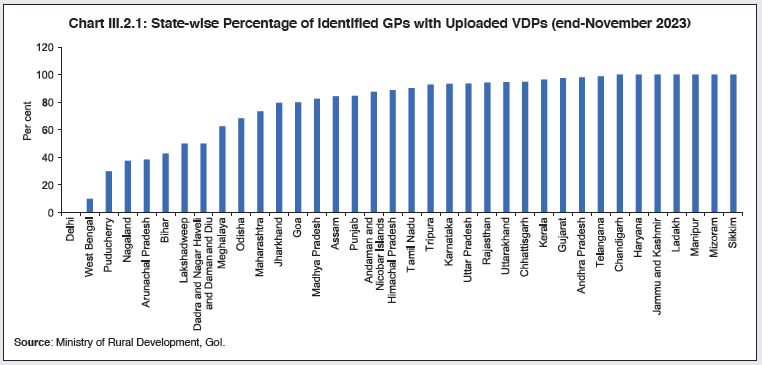
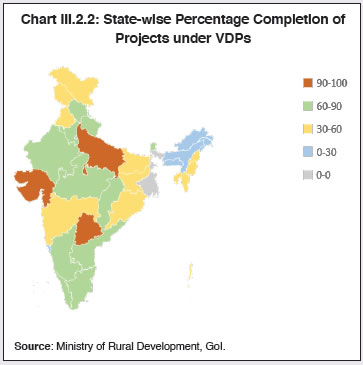 Amongst success stories, a project to provide piped water supply was completed in 2022 in Sahiyapur GP (Sitapur district, Uttar Pradesh), providing access to safe drinking water for the villagers, who were earlier primarily dependent on shallow well hand pumps. In Maravamangalam GP (Sivaganga district, Tamil Nadu), trainings in leather and coir manufacturing have been provided for enhancing livelihood opportunities. Rampur GP (Kheda district, Gujarat) has witnessed the implementation of various infrastructural projects relating to schools, health centres, roads and drainage systems. In GP Gitang Karmatar (Sikkim), 15 hectares of fallow land has been brought under cultivation through land development and land terracing. As a result, soil erosion has been reduced by about 80 per cent, increasing soil moisture and fertility. References: Annual Report 2022-23, Ministry of Rural Development. SAGY Portal, Ministry of Rural Development, Government of India. | 4. Role of Panchayats in Health 3.6 Panchayats play a significant role in providing basic healthcare facilities to rural residents in collaboration with government health departments through establishing and maintaining health centres, clinics, and dispensaries. GPs contribute to improving maternal and child health by promoting institutional deliveries, encouraging prenatal and postnatal care, and reducing maternal and infant mortality rates. Panchayats engage and train local community health workers to disseminate health-related information, provide primary care, and connect individuals to appropriate medical services. Providing access to clean drinking water and proper sanitation facilities is also an integral role of GPs, with the objective of maintaining good health and preventing waterborne diseases. Available data indicate that States, where Panchayats got high scores in health, nutrition and sanitation had lower rural infant mortality (Chart III.2). 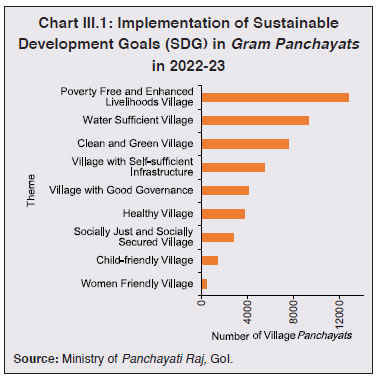 3.7 Rural India still faces around 29 per cent shortfall in rural health facilities in several States (Chart III.3). The Fifteenth Central Finance Commission (CFC-XV) recommended a total grant of ₹4.3 lakh crore for local governments covering the period from 2021-22 to 2025-26. Out of the recommended grants, ₹0.70 lakh crore was allocated for health, with ₹0.44 lakh crore specified for Rural Local Bodies (RLBs) and ₹0.26 lakh crore for Urban Local Bodies (ULBs). These grants aim to enhance health systems and address crucial gaps in primary healthcare. 5. Role of Panchayats in Education 3.8 Education is a key component of human capital formation and is critical for strengthening medium-term growth prospects. Universal primary education is crucial for the development of rural areas for enhanced agricultural skills and increased capabilities in securing employment beyond farming (Paltasingh and Goyari, 2018; Khuong, 2021). In rural areas, village Panchayats are responsible for constructing, maintaining and enhancing educational institutions, primary schools and community learning centres. Panchayats collaborate with schools and parents to encourage enrolment, minimise drop-out rates, and actively monitor school operations, teacher attendance, and educational quality. They allocate resources for educational endeavours encompassing books, stationery and other essential materials, with the aim of creating a conducive learning environment. Between 2018 and 2022, the enrolment of children aged 6-14 years in government schools in rural areas increased in all States, with Odisha, Gujarat and West Bengal recording more than 90 per cent of enrolment in government schools (Chart III.4). Nonetheless, rural primary schooling in India faces hurdles due to a variety of factors: poorly equipped buildings; limited connectivity; scarcity of qualified teachers; and low enrolment and high drop-out rates exacerbated by gender disparities and limited community engagement (Kaushik et al., 2009; Mukhopadhyay and Sarangapani, 2018). 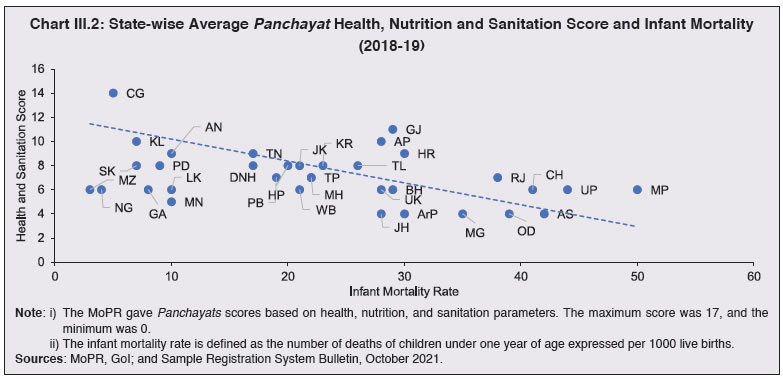
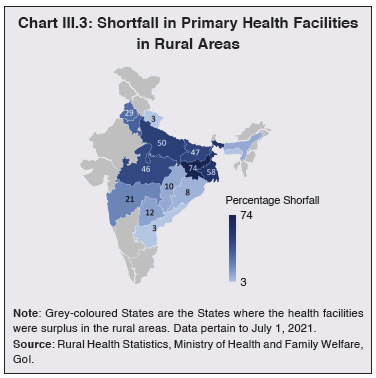
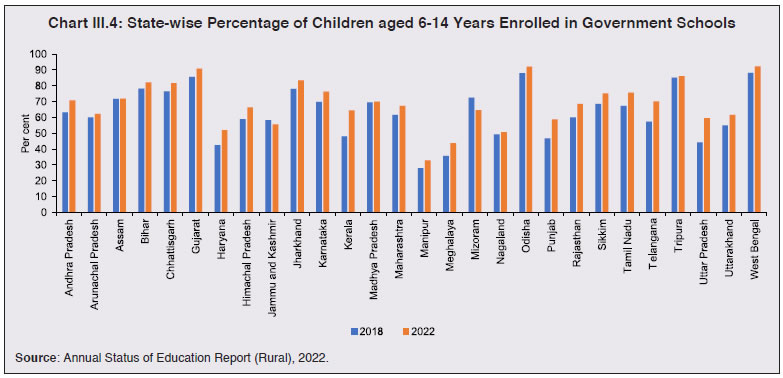 6. Panchayats and Women Empowerment 3.9 With women making up half of the population, attaining equal representation is not solely a matter of fairness but also an essential requirement for efficiency. Studies have shown that when women are involved in local governance, policy areas such as education, health, and child welfare often improve. Women leaders in local bodies have been instrumental in initiating and implementing policies that benefit children, families, and the underprivileged (Bobonis, 2009). There is a positive and significant correlation between increased women’s participation and improved outcomes in local governance (Evertzen 2001; Raabe, Sekhar, and Birner, 2009; Chattopadhyay and Duflo, 2004). 3.10 Clause 3 of Article 15 of the Constitution grants the Indian State the authority to make special provisions for women and children2. The Constitution (73rd Amendment) Act, 1992 came into force on April 24, 1993, adding a new part to the Constitution, namely, Part IX titled “The Panchayats”. Article 243D (3) of the amended Constitution guarantees women’s involvement in Panchayati Raj Institutions by stipulating a minimum one-third reservation for women in both the total seats filled by direct election and the positions of Panchayat Chairpersons. Furthermore, the positions of Chairpersons within the Panchayats, whether at the village level or any other tier, are to be reserved for SCs, STs, and women in a manner determined by the State Legislature. It is stipulated that the number of Chairperson positions reserved for SCs and STs at each Panchayat level within a State should closely align with the proportion of the population of these communities to the total State population. Additionally, it is mandated that no less than one-third of all Chairperson positions at each Panchayat level must be reserved for women. 3.11 As of September 2021, 22 States and UTs, namely Andhra Pradesh, Assam, Bihar, Chhattisgarh, Dadra and Nagar Haveli, Daman and Diu, Gujarat, Himachal Pradesh, Jharkhand, Karnataka, Kerala, Madhya Pradesh, Maharashtra, Odisha, Punjab, Rajasthan, Sikkim, Tamil Nadu, Telangana, Tripura, Uttarakhand, and West Bengal, have enacted provisions entailing a 50 per cent reservation for women in their respective State Panchayati Raj Acts3. This has led to an increase in the proportion of elected women representatives (EWR) in PRIs across the country (Table III.1). Impact of Women’s Reservation 3.12 Women elected to political positions tend to allocate resources towards goods that cater to the specific needs of local women (Chattopadhyay and Duflo, 2004). For example, they prioritise drinking water and roads over adult education centres in West Bengal, and drinking water over roads in Rajasthan. Local-level governance has positively impacted health outcomes in Bihar, including child mortality rates, institutional birth rates, and safe deliveries (Kumar and Prakash, 2012). A statistically significant relationship between women’s reservation in political roles and health outcomes has, however, not been established. An increase in the representation of women in politics is associated with a notable increase in women’s access to antenatal care, adherence to iron supplementation during pregnancy, and giving birth in government healthcare facilities rather than at home (Bhalotra and Figueras, 2014). | Table III.1 : Elected Women Representatives (EWRs) in PRIs | | State / UT | Total PRI Representatives | Total EWRs | Per cent of Women Representatives in PRIs | | Andaman & Nicobar Islands | 858 | 306 | 35.7 | | Andhra Pradesh | 1,56,050 | 78,025 | 50.0 | | Arunachal Pradesh | 9,383 | 3,658 | 39.0 | | Assam | 26,754 | 14,609 | 54.6 | | Bihar | 1,36,573 | 71,046 | 52.0 | | Chhattisgarh | 1,70,465 | 93,392 | 54.8 | | Dadra & Nagar Haveli | 147 | 47 | 32.0 | | Daman & Diu | 192 | 92 | 47.9 | | Goa | 1,555 | 571 | 36.7 | | Gujarat | 1,44,080 | 71,988 | 50.0 | | Haryana | 70,035 | 29,499 | 42.1 | | Himachal Pradesh | 28,723 | 14,398 | 50.1 | | Jammu & Kashmir | 39,850 | 13,224 | 33.2 | | Jharkhand | 59,638 | 30,757 | 51.6 | | Karnataka | 1,01,954 | 51,030 | 50.1 | | Kerala | 18,372 | 9,630 | 52.4 | | Ladakh | - | - | - | | Lakshadweep | 110 | 41 | 37.3 | | Madhya Pradesh | 3,92,981 | 1,96,490 | 50.0 | | Maharashtra | 2,40,635 | 1,28,677 | 53.5 | | Manipur | 1,736 | 880 | 50.7 | | Odisha | 1,07,487 | 56,627 | 52.7 | | Puducherry | - | - | - | | Punjab | 1,00,312 | 41,922 | 41.8 | | Rajasthan | 1,26,271 | 64,802 | 51.3 | | Sikkim | 1,153 | 580 | 50.3 | | Tamil Nadu | 1,06,450 | 56,407 | 53.0 | | Telangana | 1,03,468 | 52,096 | 50.3 | | Tripura | 6,646 | 3,006 | 45.2 | | Uttar Pradesh | 9,13,417 | 3,04,538 | 33.3 | | Uttarakhand | 62,796 | 35,177 | 56.0 | | West Bengal | 59,229 | 30,458 | 51.4 | | Total | 3,187,320 | 14,53,973 | 45.6 | | Sources: Ministry of Panchayati Raj, GoI; RBI staff estimates based on data from MoPR. | 7. Empowerment of Panchayats 3.13 With a view to incentivising the States to devolve 3Fs (Funds, Functions and Functionaries) to the Panchayats and making their functioning transparent, accountable, and efficient, the MoPR implemented the Panchayat Empowerment and Accountability Incentive Scheme (PEAIS) which remained operational from 2005-06 to 2012-13. In 2013-14, the scheme was subsumed under the Rajiv Gandhi Panchayat Sashaktikaran Abhiyan (RGPSA)4. The Rashtriya Gram Swaraj Abhiyan (RGSA) was implemented from 2018-19 for further strengthening the PRIs for achieving the SDGs with a thrust on convergence with Mission Antyodaya. The RGSA seeks to augment capacity building by providing training to designated officials and representatives, besides augmenting infrastructural support such as Gram Panchayat Bhawan and computerisation. The GoI also funds e-governance initiatives such as digitalisation of Panchayats and incentivises them through awards (including financial incentives) for recognising novel work on public service delivery. 3.14 The devolution of functions by State governments to Panchayats in India occurs in three stages (by legislation, activity mapping and government order). It is almost complete in respect of legislation for all the States/ UTs and activity mapping, but limited progress has been achieved in the third stage of devolution (John, 2019). The devolution of powers and functions to the Panchayats varies considerably across the States (Box III.3). Kerala has devolved major functions to Panchayats. Its welfare programme Kudumbashree5 has made contributions through provision of microcredit, support to micro-enterprises, and helping destitute children, women and weaker sections of the society. Similarly, Karnataka has devolved powers to Panchayats and introduced a system of preparing a Gram Panchayat Human Development Index. It has also put in place the Karnataka Local Fund Authorities Fiscal Responsibility Act, 2003 for fiscal responsibility norms to be followed by the local governments. The State has undertaken e-application tools (such as ‘Mahit Kanaja’) for accessing all public services from the Panchayats in a timely manner. Tamil Nadu has also devolved powers and responsibilities to Panchayats on all the 29 subjects. The State’s scheme Anaithu Grama Anna Marumalarchi Thittam (AGAMT)6 focuses on comprehensive development of all village Panchayats through improvement in overall basic infrastructure facilities. 8. Conclusion 3.15 Panchayats are critical to providing local governance and for stepping up rural development in India. Numerous challenges – inadequate financial resources; heavy reliance on grants from upper tiers of government; under-provision of basic human resources; weak infrastructure - impede their optimal functioning. Empowering local leaders and officials through adequate and diverse funding sources, greater decentralisation, capacity building and infrastructure upgradation is an imperative. Citizens’ awareness about the functions and significance of Panchayats needs to be increased to improve participation in local governance processes and enhance the efficacy of grassroots democracy. Panchayats can leverage upon digital tools for a more people-centric administration, communication, and data management to boost efficiency. Effectively addressing these challenges necessitates committed efforts from policymakers, local leaders, and citizens to fortify the functioning of Panchayats and expand inclusive and sustainable grassroots development. Box III.3: Status of Panchayat Empowerment in States For assessing States’ progress in empowering the PRIs, the MoPR has been publishing a devolution index7 since 2006. Kerala, Karnataka, Tamil Nadu, and Maharashtra score high in terms of the index. States with higher devolution index scores are found to have better quality of socio-economic development (Charts III.3.1a and III.3.1b). and higher levels of computerisation (Chart III.3.2a and III.3.2b).
States remain at variance regarding the infrastructure availability of Gram Panchayat Bhawans, which play an important role in delivering various services, especially under the Common Service Centre and Digital India Programme (GoI, 2018a). States with higher devolution index scores have larger proportions of Gram Panchayats with Bhawans (Chart III.3.3). Concerted efforts should be made towards augmentation of Panchayats’ empowerment to effectively plan economic development and social justice schemes (GoI, 2018a). References: Asfaw, Abay, Klaus Frohberg, K. S. James and Johannes Jütting (2007). Fiscal Decentralization and Infant Mortality: Empirical Evidence from Rural India, The Journal of Developing Areas, Vol. 41, No. 1 (Fall), pp. 17-35. Government of India (2017). Devolution Report 2015-16, Ministry of Panchayati Raj. Available at: 2023022277.pdf (s3waas.gov.in) Government of India (2018a). Standing Committee on Rural Development (2018-2019), 57th Report, Lok Sabha Secretariat, December. Available at: https://eparlib.nic.in/bitstream/123456789/783409/1/16_Rural_Development_57.pdf Government of India (2018b). PIB Press Release, January 29. Available at: https://pib.gov.in/PressReleasePage.aspx?PRID=1518051 Government of India (2020). Economic Survey 2019-20. Government of India (2020). XV Finance Commission Report, Volume-I Main Report, October. Government of India (2022). Vice President’s Speech on April 11, 2022, Ministry of Panchayati Raj. Available at: https://pib.gov.in/PressReleasePage.aspx?PRID=1815682 Government of India (2023). Standing Committee on Rural Development and Panchayati Raj (2022-23), 31st Report, Lok Sabha Secretariat, March. John, Jacob (2019). Economic Development and Income Generation through Panchayats in Rural Areas, Report Submitted to Ministry of Panchayati Raj, Government of India, July. Kumar, Santosh and Nishith Prakash (2012). Political Decentralization, Women’s Reservation and Child Health Outcomes: A Case Study of Rural Bihar, University of Connecticut Department of Economics Working Paper Series 2012-18, September. Available at: https://media.economics.uconn.edu/working/2012-18.pdf |
|